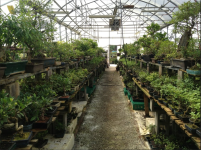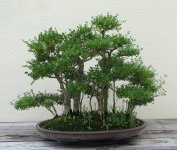Seattle Bonsai Newb
Seedling
- Messages
- 13
- Reaction score
- 4
Mr
It's not that "Put it out in the sunlight." is unacceptable (in my mind all responses are acceptable) it's more that it's questionable.
1. Tree's previous home had low light and high humidity (see pic below). Tree's current home has more light and similar humidity.
NOTE: Photo is from Asia Pacific Gardening, the happy homeland of likely most Serissa in US. Recommend to have a look at their website, very interesting.
2. Staff at APG say it's OK to have tree inside, just needs to be located near a window that gets good light and to water daily.
3. Serissa is a small tropical shrub, it undoubtedly evolved methods to survive in low (in shade of taller trees) and high (out of shade) light conditions, but probably not low humidity conditions.
4. In short, broad solutions broadly work, unless you happen to be in the minority. As a career aerospace problem-solver, could go into the method, theory and science of the problem-solving but might be out of scope in this forum. I can do a couple of paragraphs (it's simple) but only on request.
Look, lots of people complain about not being able to keep Serissa, yet they thrive in certain conditions. A more thorough/detailed explanation of their care would help many. These small trees are sold to 1000's of people per year, thinking they'll be able to keep them nearby INSIDE. I think it's completely possible (and so does APG) to keep serissas inside, just need to figure out the right combination. Having said all that, I'm looking for a suitable location for the tree outside as that may currently be its best bet going forward.
Mr. Attmos, sir, well played.Why is "Put it out in the sunlight." not an acceptable response?
It's not that "Put it out in the sunlight." is unacceptable (in my mind all responses are acceptable) it's more that it's questionable.
1. Tree's previous home had low light and high humidity (see pic below). Tree's current home has more light and similar humidity.
NOTE: Photo is from Asia Pacific Gardening, the happy homeland of likely most Serissa in US. Recommend to have a look at their website, very interesting.
2. Staff at APG say it's OK to have tree inside, just needs to be located near a window that gets good light and to water daily.
3. Serissa is a small tropical shrub, it undoubtedly evolved methods to survive in low (in shade of taller trees) and high (out of shade) light conditions, but probably not low humidity conditions.
4. In short, broad solutions broadly work, unless you happen to be in the minority. As a career aerospace problem-solver, could go into the method, theory and science of the problem-solving but might be out of scope in this forum. I can do a couple of paragraphs (it's simple) but only on request.
Look, lots of people complain about not being able to keep Serissa, yet they thrive in certain conditions. A more thorough/detailed explanation of their care would help many. These small trees are sold to 1000's of people per year, thinking they'll be able to keep them nearby INSIDE. I think it's completely possible (and so does APG) to keep serissas inside, just need to figure out the right combination. Having said all that, I'm looking for a suitable location for the tree outside as that may currently be its best bet going forward.



